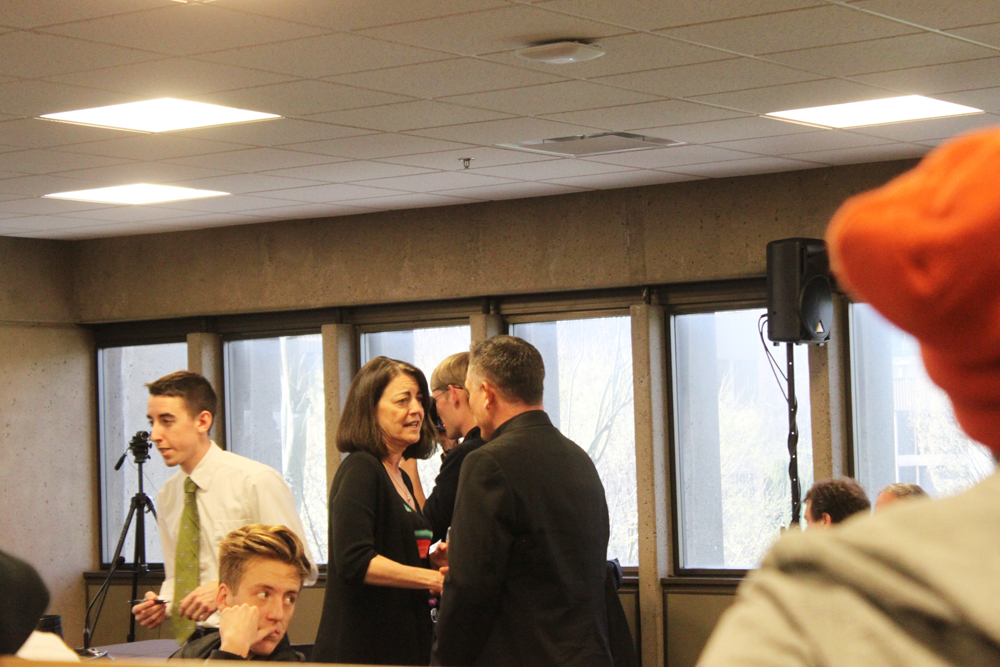The Portland State Board of Trustees voted 10-2 at the winter term quarterly Board meeting to approve a resolution that outlines a 4.2 percent increase in tuition and fees for resident undergraduates. The increase will take effect Fall 2015.
Trustee Sho Dozono and student trustee Maria Carolina-Gonzalez-Prats voted against the resolution.
“To have to raise tuition is very difficult,” said trustee Christine Vernier. “We absolutely need more state funding.”
At the meeting, PSU President Wim Wiewel said the 4.2 percent overall rise would also be paired with a proposed $4.7 million in cuts in order to balance the budget.
The Board chose the “middle road,” according to University Communications Director Scott Gallagher. He said there would either be no increase in tuition and $9 million in cuts or the approved 4.2 percent increase paired with smaller cuts.
For an in-state undergraduate student taking 15 credits, this vote translates to a $110 per term increase, according to the Board Resolution Concerning 2015–16 Tuition Rates.
Specifically, the Board approved a $7 per credit increase for resident undergraduate students, a $15 per credit increase for non-resident undergraduate students, and a $17 per credit increase for non-resident graduate students.
During the meeting, Wiewel gave a detailed presentation of the proposed tuition rates for the 2015–16 academic year. He answered questions from the Trustees before they voted on the resolution.
Student Budget Advisory Committee input
The resolution outlines the budget process taken before it reached the Board. According the resolution, Wiewel worked with the Student Budget Advisory Committee to set a tuition rate proposal for the Board.
The resolution also quotes the Board’s Tuition, Fees, and Fines Policy, which requires that Wiewel establish a means to student participation in the development of a recommendation regarding tuition and fees.
The SBAC is chaired by Vice President of Finance and Administration Kevin Reynolds. The committee also includes Daniel Fortmiller, Interim Vice President of Enrollment Management and Student Affair; Laura Nissen, Dean of the School of Social Work; Alan Finn, Assistant Vice President of Budget and Finance; Andria Johnson, Assistant Director of the Budget Office; and Sharon Rivers, Budget Analyst at the Budget Office.
The student members of the committee are Andy Mayer, Jessica Harn, Gregory Elkins and Patrick Vroman.
According to the resolution, “The student members of the SBAC provided a recommendation to the President that there be no increase to any category of tuition or mandatory student fees.”
In a budget recommendation letter signed by the four student members of SBAC, they wrote, “We feel that we represent the needs and concerns of students at [PSU]…We make our recommendations while fully recognizing the university’s substantial financial hardship.”
They cited two main reasons for their recommendation against tuition increase: untold financial hardship and the notion that students will not see value from an increase in tuition.
“Even the smallest increase in tuition can cost many students a week of groceries or force many to skip meals,” they wrote.
They continued, “[T]he only justification for a rise in the cost of tuition would be an increase in the academic quality, programs, or services offered…this is not currently feasible.”
The student members provided recommendations to the president for reducing financial burden for students. These included a review of the PSU Payment Plan and optional health insurance, as modeled by Oregon State University and University of Oregon.
In a letter to the president written by Reynolds in February regarding the Tuition and Fee proposal of 2015–16, Reynolds outlined the student members of SBAC’s recommendation not to increase tuition and fees.
“Faculty and staff members of the committee share their concerns about the financial hardships students face, and the hope that the State of Oregon allocates sufficient funds allowing to both lower the tuition increase, address our budget gap, and provide additional services to students,” he wrote.
Reynolds’ letter noted that the student members of SBAC do not anticipate an increase in federal and state financial aid, while the budget forecast for financial year 2016 includes a 6.5 percent increase in the tuition remission budget. Tuition remissions allow the Financial Aid Office to provide direct aid to students with the highest need, according to Reynolds.
Fund allocation
At the meeting, Wiewel discussed the possible difficulties of a zero percent increase.
“While we know that raising tuition poses hardship, simply cutting costs provides hardships, too,” he said. “It will reduce access. We will have to make cuts, it will deteriorate quality of education, cut back on financial aid, have fewer advisers—whatever the simple cuts are, we cannot ignore the fact that that imposes its own hardships too.”
“The extra tuition is not paying for buildings, for new programs,” Gallagher said. “It is merely to make up for lack of state funds.”
Money for renovations and new buildings, such as the soon-to-be Viking Pavilion, comes from fundraising and the State Capital budget.
“It’s very important to understand that when we renovate, none of that money comes from student tuition,” Gallagher added.
Gallagher said the university has been under an administrative salary freeze for the last two years.
“To say that this is going towards administration is absolutely incorrect,” he said.
He added that while he himself has not received a raise in the past two years, the teachers who went on strike last year did.
Implementations
Though the Board voted to approve the tuition increase, it is possible the percentage increase could lessen, depending on available state funding.
“Whatever increase in funding we get from state at this point, will draw [the increase] down,” said Eric Noll, president of ASPSU. “That is what we expect. There’s no signed agreement, but we expect our administration to do that. We expect the 4.2 conglomerate percent to come down for every dollar we get…Depending on outcome-based funding allocation, if we get another bump there, that may draw us down further. We have a good shot if we get a reinvestment from the state.”
“We continue to focus on other cost reductions,” Wiewel said in his closing comments. “We are already a low-cost producer in the state, and the state is a low-cost producer in the nation. Nobody in the country has figured out how to do education at a much lower cost than we do here. So, I don’t see how we can really do that. On the whole, I believe that a better tactic would be to focus on revenue increases rather than cost deductions.”
Wiewel said PSU is considering changes to the nature of the health insurance on campus. Currently health insurance is required for all students taking at least five credits.
He talked about philanthropy-based revenue increases. He also said that PSU is in the early stages of testing another approach to “public funding of a very different nature,” though, he said, “We’re not ready to talk about that right here and now.”
In the SBAC letter to Wiewel, Reynolds discussed many of the same elements presented by Wiewel at the Board meeting that may change the final percentage of tuition increase. This includes the level of state funding and Higher Education Coordinating Commission’s potential implementation of outcome-based funding in 2016.
“If this [outcome-based] model is implemented in 2016 and there is some immediate recognition of the historical funding disparities for PSU, we may see additional revenues,” Reynolds said. “However, I think it is important to approve these tuition increases now, so our students can have some certainty about the maximum likely cost of attendance for the 2015–16 academic year.”
Additional Reporting by Jessica Pollard and Chelsea Lobey.





